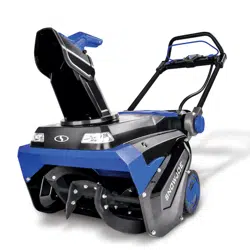Loading ...
Loading ...
Loading ...

14
2. Use 2 10 mm wrenches to remove the bolts and nuts that
are used to fix the right side panel. Then remove the right
side panel to expose the belt, as shown (Fig. 24).
NOTE: The 2 bolts located on the left have 2 nuts on the back,
while the other 4 bolts don’t. Use one 10 mm wrench to hold the
left two bolts steady and remove the nuts with the other 10 mm
wrench first, and then remove all the bolts.
3. Remove the drive belt by slowly turning the auger pulley
counterclockwise while pulling the belt outwards (Fig. 25).
4. Install the new drive belt, rotating it onto the pulleys
(Fig. 26).
Right side
panel
Bolts
Nuts
Old belt
Fig. 24
Fig. 25
Drive belt
Auger pulley
New drive
belt
Auger pulley
Engine
pulley
Fig. 26
NOTE: Rotate the new drive belt first around the engine pulley,
then around the auger pulley. Slowly turn the auger pulley
clockwise to drive the belt inwards.
5. Replace the side panel on the unit, secure with the original
hardware. The snow blower is ready to use.
Storage
1. Examine the cordless snow blower thoroughly for worn,
loose or damaged parts. Should you need to repair or
replace a part, contact an authorized Snow Joe
®
+ Sun
Joe
®
dealer or call the Snow Joe
®
+ Sun Joe
®
customer
service center at 1‑866‑SNOWJOE (1‑866‑766‑9563) for
assistance.
2. Clean the snow blower before storing or transporting.
Be sure to secure the unit while transporting.
3. Remove the battery packs from the cordless snow blower
before storing.
4. Store the cordless snow blower indoors in a locked, dry
place out of the reach of children to prevent unauthorized
use or damage.
Battery + Charger O-Season Storage
• Do not expose your battery packs or chargers to water,
rain or allow them to get wet. This could permanently
damage the chargers and the battery packs. Do not use
oil or solvents to clean or lubricate your battery packs as
the plastic casing can become brittle and crack, causing a
serious risk of injury.
• Store the battery packs and chargers at room temperature
away from moisture. Do not store in damp locations where
corrosion of terminals may occur. As with other battery
pack types, permanent capacity loss can result if the pack
is stored for long periods of time at high temperatures
(over 120
º
F/49
º
C).
• 24V iON+ lithium‑ion battery packs maintain their charge
during storage longer than other battery pack types. As a
general practice, it is best to unplug the battery chargers
and remove the battery packs when they are not in use.
Recharge the battery packs every 6 months to 50%
capacity (2 lights on) during off‑season storage to maintain
optimal battery performance.
Battery Caution +
Disposal Information
Always dispose of your battery packs according to federal, state,
and local regulations. Contact a recycling agency in your area
for recycling locations.
mCAUTION! Even discharged battery packs contain
some energy. Before disposing, use electrical tape to cover the
terminals to prevent the battery pack from shorting, which could
cause a fire or explosion.
Loading ...
Loading ...
Loading ...
